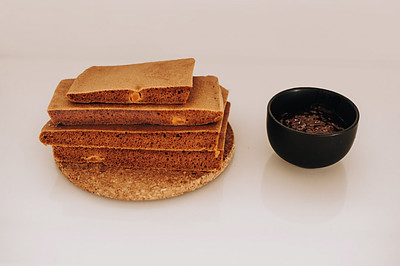| Summary | Xanthan Gum (E415) |
|---|---|
| Essence | Xanthan Gum or E415 is a complex exopolysaccharide (EPSs or a substance among others capable of altering the sensory properties of foods) produced through aerobic submerged fermentation of the plant-pathogenic bacterium Xanthomonas campestris pv. campestris which is a microorganism found naturally on cabbages. |
| Sourcing | It is most often made out of Corn, Wheat, Milk, or Soy. But, essentially, anything that contains sugar can be used as a source for creating Xanthan Gum. |
| Manufacturing | Xanthan Gum is prepared by the plant-pathogenic bacteria being inoculated into a clean and sterile aqueous fluid of carbohydrate (glucose and sucrose), a source of nitrogen, dipotassium phosphate, and some micronutrients. The medium is well-aerated as well as stirred while the xanthan polymer is made extracellularly into the medium. After one to several days, the polymer is precipitated from the medium by the enhancement of isopropyl alcohol. Then, the thing is dried and powdered which is easily soluble in water or saltwater. |
| Application | Thickening agent, stabilizer, and emulsifier. Typically contains no more than 0.05-0.3% of a food. |
| Acceptable Daily Intake | 10-13 grams cause no adverse effects. Safe in doses up to 15 grams per day (an amount impossible to reach through a typical diet). |
| Side Effects | It may but not necessarily will cause intestinal gas, bloating, softer stools, increased bowel movements. |
| Benefits | It can potentially help lower cholesterol levels, improve weight loss, fight diabetes, have anti-cancer properties, foster gut health as a Prebiotic. |
| Studies | 1800+ studies on Pubmed. 65+ studies on safety. |
| Allergens | Possibly Corn, Wheat, Milk, or Soy. |
| Diet Restrictions | It is okay for vegans, vegetarians, and all religious groups. |
| Assessment (As An Additive) |
Harmless (at the very least). Realistically, slightly beneficial. |
| Products | Used in supplements like Qunol Liquid Turmeric, Skinny Fit Super Youth Chocolate Cake, Ancient Nutrition Multi Collagen Protein Chocolate, and others. Used in foods like ice-creams, Gluten-Free baked goods, soups, fruit juices, salad dressings, sauces, syrups, and others. |
As Far As Animal Studies, There Isn’t Anything To Be Concerned About
Generally speaking, the end results from animal research on Xanthan Gum aren’t really worrying at all.
In one study, rats were fed Xanthan Gum for two years in amounts of 0.25, 0.50, or 1.0 g on kg body weight daily. The only noteworthy difference comparing the Xanthan Gum groups and the control group was that rats fed Xanthan Gum experienced soft stools to some extent more often than the control rats, however even that hardly reached statistical significance. There were no disparities as far as growth rate, survival, blood markers, organ weights, or cancer likelihood [R].
Another study followed a rather identical design however chose dogs instead of rats, and the outcomes were the same. There were no changes besides periodic soft stools. In three-generation reproductive design research, rats were fed either 0.25 or 0.50 g/kg daily. There were no considerable changes in the earlier generation and its offspring from the Xanthan Gum-receiving groups [R].
Hinged on those initial reports, it was concluded that Xanthan Gum is a completely safe food additive. Ever since, not that many extra animal reviews with various objectives have actually been published.
One research paper, performed to assess the impacts of Xanthan Gum on food digestion in rats, discovered that a diet plan including 4% Xanthan Gum increased the quantity of water in the intestines by 400%. It likewise increased the number of sugars remaining in the intestinal tract. Another research paper discovered that in rats fed 50 g/kg of Xanthan Gum (an exceptionally high dosage) for 4 weeks, the contents of stool water and short-chain fatty acids content increased substantially [R, R].
This last study in fact associates with the possible anti-anticancer capacity of Xanthan Gum, and scientists discovered that orally administered Xanthan Gum had the ability to slow cancer development and lengthen the survival of mice with skin cancer. The mechanism is, however, unclear [R].
Human Studies Are Too Looking Good, Even With High Amounts
Due to the absence of hazardous effects observed in animal reviews, there are a couple of human research studies on Xanthan Gum.
One paper aspired to figure out the safety of Xanthan Gum when ingested by people in a daily dietary setting. Still, this was at levels considerably higher than anyone would typically encounter in their diet. For 23 days, five adult males without any gastrointestinal issues took 10.4 grams to 12.9 grams of Xanthan Gum every day (based upon the subjects’ weight), which is 15 times the Acceptable Daily Intake which is currently set at 10 milligrams on every kg. All in all, they experienced a decrease in serum cholesterol, a boost in fecal bile acid, and a boost in stool output and water contents [R].
Another research study had volunteers take in 15 grams of Xanthan Gum each day for 10 days. They discovered Xanthan Gum to be an extremely effective laxative. To that end, subjects reported higher stool output and gas. Which is not unexpected at all taking into account the high dosage [R].
But there is one particularly fascinating aspect when it comes to this study. It has to do with this notion of the capacity for our fecal bacteria to metabolize Xanthan Gum [R].
The scientists discovered that prior to the trial, bacteria from the stools of just 12 out of the 18 people were able to break down the Xanthan Gum. After the trial, that number increased to 16. On top of that, the stool samples encompassing bacteria that could break down the Xanthan Gum revealed a much higher production of hydrogen gas and short-chain fatty acids after the study as compared to what was observed before it. This indicates that the intestinal tract bacteria of humans rapidly adjust to this brand-new food source. This just means that Xanthan Gum (like numerous other indigestible carbs) can have an extensive influence on the gut microbiota in high dosages [R].
At the end of the day, according to the available research, there is only one group of people that can be harmed by Xanthan Gum. More precisely, the only group being troubled by the polysaccharide are infants which seems to be due to their immature digestive systems which appear to be way more sensitive to short-chain fatty acids contents just in general. Hence, Xanthan Gum shouldn’t be given to them [R, R, R, R].
Whereas as for anyone else, even in very high doses the substance is incapable of damaging our intestinal mucosa. In fact, it’s actually beneficial [R, R, R, R, R, R].




Great article Matiss! Looking forward to more dissections on additives.
Hey, Telstar!
I appreciate that. Thank you!
Looking forward to making some more of these, too.
Cheers,
Matiss